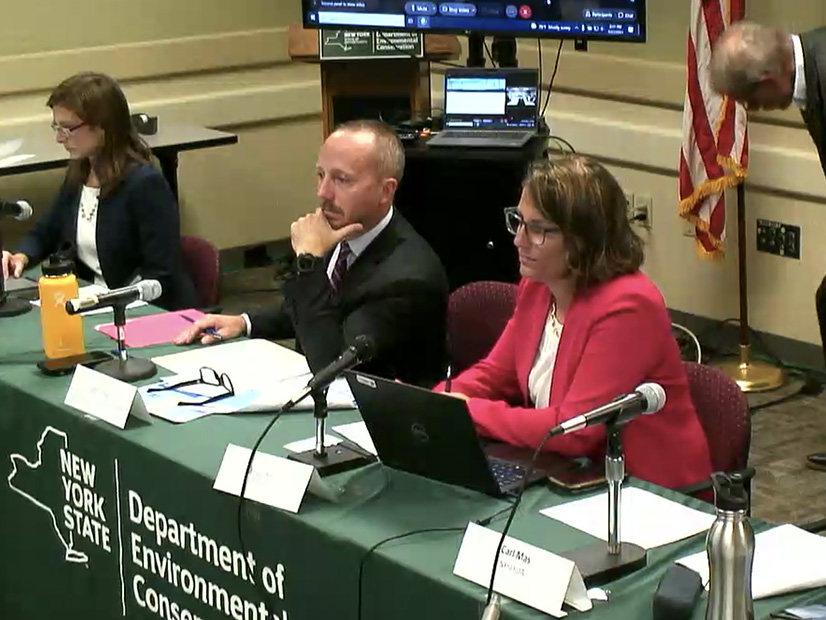Environmental justice advocates on Thursday told New York officials to consider smoke from western wildfires a week after torrential rains flooded the subway as a sign to hurry up on forming climate policy for the power sector.
“In a week where we’re seeing red moons and yellow skies … we’re talking about a moratorium on fossil fuel when it should be a no-brainer,” said Eddie Bautista, executive director of the New York City Environmental Justice Alliance. “Don’t be the mayor in Amity Island [Jaws] that doesn’t listen to the sheriff. Close the beaches. This is that analogy.”
Members of the Climate Justice Working Group (CJWG) on July 22 gave feedback to the New York State Climate Action Council (CAC) on policy recommendations from its Power Generation Advisory Panel.
The 22-member council is working to complete a scoping plan by year-end to help achieve the state’s goals under the Climate Leadership and Community Protection Act (CLCPA).
In its recommendations to the council, the Power Gen panel said that electrifying buildings and transportation will be crucial to meeting the state’s ambitious goal to reach net-zero electricity by 2040. It recommended minimizing electrification costs by balancing behind-the-meter with grid-side costs and using bulk and local solutions. It also said that storage, managed load and clean dispatchable generation could optimize deployment and operation of resources: “Look to utilities, DER providers and bulk providers for this — as makes most sense, and with steady improvement and rules.”
Affordability, False Promises
On affordability, Sonal Jessel of WE ACT for Environmental Justice, sought an emphasis on the need for major reform for utility bill assistance.
“If we move towards more electricity, what is that going to do to people’s utility costs, especially for lower income individuals?” Jessel asked.
It’s important to have no energy burden exceed 6% of income, but there are 1.2 million New Yorkers over that line, which proves the need to prioritize modifications to the state’s low-income home energy assistance program, she said.
The CJWG supports launching an assessment and planning process to determine emissions-reduction targets to reach net-zero by 2040, Bautista said. Grid reliability can be maintained and adequate CLCPA-compliant resources like clean generation, battery storage, demand response, etc., can be planned for and implemented as fossil generation resources are retired in order to achieve the 2040 target.
Environmentalists like the Power Gen panel’s interest in expanding workforce development and renewable energy and to phase out existing fossil fuel plants, but are concerned about the promotion of “false solutions” like green hydrogen, renewable natural gas and waste-to-energy, Bautista said.
In terms of the achievement of power production, 100% free of emissions by 2040, the CJWG is concerned about demonstration projects distracting from the clear renewable energy goals, he said.
The CJWG highlighted the recommendation for further research and consideration of lifecycle GHG accounting and potential air quality and health impacts of “unproven” technologies, Bautista said.
“Industry-supported technology fixes promise to reduce emissions despite their questionable legality under the CLCPA, but research shows they often do the opposite and often don’t reduce pollution burden,” he said.
In addition, NYISO should be more transparent, with more checkpoints and opportunities for public input and critique, Bautista said. “For example, the NYISO’s reliability needs assessment can be better disseminated and shared with local energy advocates … and there needs to be more energy advocates considered for appointment to the board of NYISO.”
Equitable Benefits
The state needs to make a careful examination of the equitable development of infrastructure, including the distribution system, in the context of the CLCPA mandate to spend between 35% and 40% of clean energy investments in low-income communities, said Raya Salter, lead policy organizer for NY Renews.
The CLCPA mandate on clean energy investments in low-income communities could include rate cases as well, Salter said.
“We do not have the complete roadmap on how we’re going to get there in a way that fulfills the mandate and provides a complete equitable solution across all ratepayers,” Public Service Commission Interim Chair John B. Howard said.
The commission hopes to conclude its low-income proceeding relatively soon, over the next month or two, but it will be an ongoing proceeding because these issues become more acute as you add more costs to the system, Howard said.
New technologies and rebuilding the entire electric generation system are enormously expensive, and funding the rebuilding entirely on ratepayer bills “will be nearly impossible,” Howard said. “We’ll need other sources of funding. … We have mandates, so we must spend the money.”
The Climate and Community Investment Act (CCIA) (S4264A), which proponents estimate could raise up to $15 billion per year over the next decade via a carbon tax, could pay for a large part of the costs of rebuilding the state’s power grid and infrastructure, Bautista said.
“It will be helpful if we can get our partners in government to sit down and actually look at the CCIA that was introduced in both houses last session,” he said. “We have a budget coming up and that’s a perfect opportunity to see where the CCIA could add value.”
CAC Executive Director Sarah Osgood laid out a timeline for the Council, which aims to issue a draft scoping plan by year-end and hold public meetings throughout 2022 before issuing a final plan in 2023.


